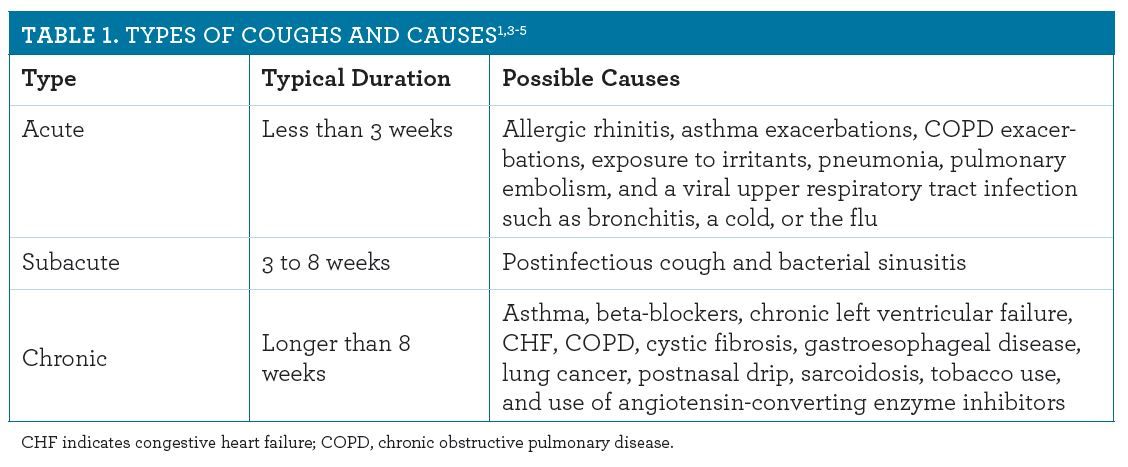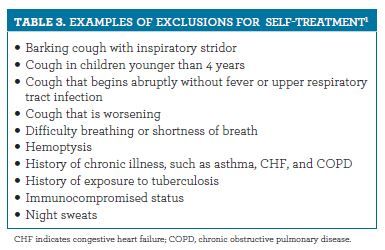Calming Acute Coughs With Nonprescription Products
A cough is a common symptom for which some patients seek medical attention at urgent care clinics and emergency departments.
A cough is a common symptom for which some patients seek medical attention at urgent care clinics and emergency departments. However, some patients initially elect to self-treat a cough with an OTC product.1 Many patients experience coughing episodes during the cold and flu season, as well as during the peak times of allergy season, because of congestion and postnasal drip. The selection of OTC cough products may be overwhelming for some patients, especially those with preexisting medical conditions or who are taking other medications.
Pharmacists are in a pivotal position to evaluate and aid patients in selecting OTC cough products when appropriate. They can also encourage patients to seek further medical care when warranted, especially if the cough’s origin is unidentified or the patient is experiencing a persistent cough or displaying signs of a respiratory tract infection. Because of their expansive drug knowledge, pharmacists can also identify patients who experience a cough because of medical conditions or the use of certain medications and advise them accordingly on how to address the issue. Pharmacists can also detect patients who may be abusing cough syrup, a common trend among teens known as “robotripping.”2 Unfortunately, according to the National Institute of Drug Abuse, dextromethorphan is 1 of the 2 most commonly abused OTC medications, especially among teens.2
Cough Types and Causes
A cough can be classified as acute or chronic. It can be the result of certain medical conditions, exposure to allergens or irritants, an infection, or the use of certain medications (Table 1).1,3-5 For example, an estimated 20% of patients who take an angiotensin-converting enzyme inhibitor experience episodes of dry cough.1,4 Furthermore, the use of systemic and ophthalmic β-adrenergic blockers may produce a cough in patients with conditions such as asthma and chronic obstructive pulmonary disease (COPD).1,4
Furthermore, coughs can be classified as nonproductive or productive. Although most coughs resolve on their own, the common bothersome effects may negatively affect overall quality of life by interfering with the ability to sleep or causing exhaustion, chest pain, fatigue, headaches, hoarseness, musculoskeletal discomfort/pain, and urinary incontinence.1,5-7 Patients with chronic coughs should be assessed to ascertain the etiology of the cough or rule out any other potentially serious medical conditions.

The primary goals for self-treatment of a cough are to eradicate the cough and to avert complications. Because treatment of cough is symptomatic, the underlying cause must be identified and treated as well.1,4 For the self-treatment of cough, available OTC products include expectorants, oral antitussives, and topical antitussives, which are available in several dose forms, as well as single-entity or combination products that contain both an antitussive and a protussive agent (Table 2).1,4
Antitussives
Codeine
At antitussive doses, codeine is classified as a Schedule C-V narcotic and is available without a prescription in many states.1 Codeine is indicated for the suppression of a nonproductive cough caused by chemical or mechanical respiratory tract irritation. It acts centrally on the medulla to increase the cough threshold, and when administered at antitussive doses, codeine has low toxicity and little risk of addiction.1 The most common adverse effects of codeine at antitussive doses are constipation, dizziness, nausea, sedation, and vomiting, and it should be used with caution by those with asthma, COPD, existing respiratory depression, or drug addictions.1,4
Dextromethorphan
Most OTC cough suppressants contain dextromethorphan, which is indicated for the suppression of a nonproductive cough caused by chemical or mechanical respiratory tract irritation.1,4 Dextromethorphan is well absorbed after oral administration with a 15-to-30-minute onset of action and a duration of effect of 3 to 6 hours.1 Although infrequent, adverse effects include constipation, drowsiness, nausea, stomach discomfort, and vomiting.1,4
Diphenhydramine
Diphenhydramine is classified as a nonselective first-generation antihistamine with significant anticholinergic and sedating properties.1 Although approved by the FDA as an antitussive, it is not considered a first-line antitussive but is found in many allergy and cold products, along with other ingredients.1 Diphenhydramine acts centrally in the medulla to increase the cough threshold and is indicated for the suppression of nonproductive coughs caused by chemical or mechanical respiratory tract irritation.1 The most common adverse effects are blurry vision, drowsiness, dry mouth, respiratory depression, and urinary retention.1,4
Other Antitussives
The only 2 FDA-approved topical antitussives are camphor and menthol, which are found in ointments and inhalation form.1 Patients should be counseled about the proper use of these agents and be advised to use them only as directed by the manufacturer. Menthol is found in many throat lozenges for treating coughs as well.1,4
Expectorants
Guaifenesin is the only FDA-approved expectorant also recognized as a protussive agent and is indicated for the symptomatic relief of an acute ineffective productive cough.1 Although the pharmacokinetics of guaifenesin are not well understood, it appears to be well absorbed after oral administration, with an estimated half-life of about 1 hour.1 The use of guaifenesin is not associated with any known drug—drug interactions and is normally well tolerated. However, while infrequent, adverse effects such as dizziness, gastrointestinal upset, headache, nausea, rash, nausea, and vomiting have been reported.1 Guaifenesin should not be used to treat a chronic cough associated with chronic lower respiratory tract diseases such as asthma, COPD, emphysema, and smoker’s cough.1,4
Conclusion
Prior to recommending any OTC cough products, pharmacists should ascertain whether self-treatment is appropriate and should always evaluate the allergy and medical history as well as the medication profile to check for potential contraindications or drug interactions. Lactating and pregnant women and those with chronic medical conditions or who are taking other medications should always consult their primary health care providers before using any OTC cough medications. Pharmacists can also remind patients with hypertension about the decongestant-free cold and cough products marketed specifically for this patient population, such as Coricidin HBP.
Remind patients to read labels prior to administration and to check ingredients, especially if they are using multiple products, to avoid therapeutic duplications and excessive dosing. Patients should adhere to the administration guidelines, duration of use, and recommended doses. Caregivers and parents should give children only those OTC products manufactured specifically for the pediatric population and adhere to the manufacturer’s recommendations, particularly in terms of age limits for use. They should always consult their pediatricians or pharmacists when in doubt about the appropriateness of dose or use.
Because a cough may be a symptom of many acute and chronic medical conditions, self-treatment may delay identification of the underlying cause and thus postpone proper treatment to resolve the cough.1 Individuals with signs of a chronic cough should be encouraged to seek further medical evaluation, especially if the source is unknown or if the cough is not improving or is worsening (Table 31). In many cases, a cough will cease or improve if the underlying cause can be modified, prevented, or treated.1,3 Patients with a smoker’s cough should be encouraged to consider smoking cessation programs.6 Patients exhibiting signs of a bothersome cough that is likely due to the use of certain medications should talk to their pharmacist or primary health care providers about recommending another drug class not associated with a cough, if applicable.

Yvette C. Terrie, BSPharm, RPh, is a consultant pharmacist and a medical writer based in Haymarket, Virginia.
References
- Tietze, KJ. Cough. In: Krinsky DL, Ferreri SP, Hemstreet B, et al, eds. Handbook of Nonprescription Drugs. 19th ed. Washington, DC: American Pharmacists Association; 2018:217-230.
- Over-the-counter medicines. National Institute on Drug Abuse website. drugabuse.gov/publications/drugfacts/cough-cold-medicine-abuse. Updated December 2017. Accessed February 20, 2018.
- Chen HH. Chronic cough. Medscape website. emedicine.medscape.com/article/1048560-overview#a3. Published January 26, 2016. Accessed February 20, 2018.
- Dlugosz C. Cough. In: The Practitioner’s Quick Reference to Nonprescription Drugs. 2nd ed. Washington, DC: American Pharmacists Association; 2012:75-84.
- What causes cough? National Heart, Lung, and Blood Institute website. www.nhlbi.nih.gov/node/4489. Accessed February 20, 2018.
- Cough. MedlinePlus website. nlm.nih.gov/medlineplus/ency/article/003072.htm. Accessed February 20, 2018.
- Pratter MR. Overview of common causes of chronic cough: ACCP evidence-based clinical practice guidelines. Chest. 2006;129(suppl 1):59S-62S. doi: 10.1378/chest.129.1_suppl.59S.

